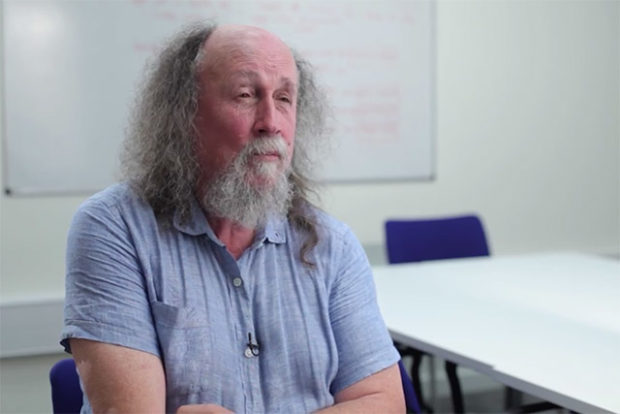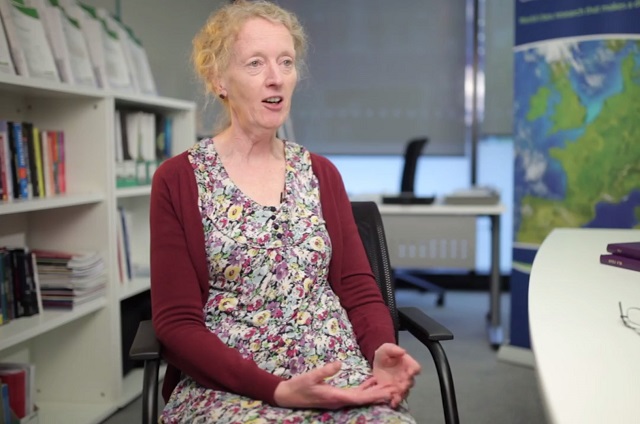Rapid Climate Change and Species
Professor of Biosphere and Climate Impacts Iain Colin Prentice on the history of climate changes, the ways of dealing with changes in climate, and the role of overhunting in extinction of mammalian species
videos | September 27, 2017
The video is a part of the project British Scientists produced in collaboration between Serious Science and the British Council.
If you read a lot of scientific papers on the subject, you get the impression that the rapid climate change that is evidently starting now is something completely unprecedented. It’s not true. Those of us who are interested in past climate changes realize that rapid climate changes have happened before. It’s certainly not the same, certainly not with the same causes what we see now, but they did actually happen. In particular, they happened during and at the end of ice ages.
During the last two or three million years, the Earth has actually more often being in an ice age than in the warm period that we are in now. In fact, about 80% or 90% of the time during that period the Earth has been in an ice age. During those ice ages there were some strange things happening called Dansgaard–Oeschger events. or DO-cycles. At some point this happened repeatedly during ice age.
During the last ice age there were about twenty such events. What happened was a rapid warming followed by gradual cooling. The rapid warming took place in between about 50 and 200 years, the cooling was slower than that. The magnitude of the warming was rather large. It was spatially variable: being largest in the high latitudes, but in Greenland, for example, we know from ice score records that these warmings were of an amplitude up to 16 degrees, that’s a very big warming in low latitudes. Something more like five degrees, but nevertheless very substantial warming in a rather short period of time.

We know a great deal in excruciating detail about what happened more or less year by year 11700 ago, which was when the final phase of the last ice age, called the Younger Dryas period came to an end. During that transition there was a global warming by somewhere between five and seven degrees, and it took place in less than 20 years.
If you read the literature about present species distribution and climate change, you might get the impression that we were about to suffer mass extinctions of large numbers of species on the grounds that they can’t keep up with rapid climate change. Well, we do know during that transition period at the end of the ice age there certainly were extinctions, they didn’t happen immediately, but certainly in a rather limited period around that time. There were large mammals, in particular, such as the woolly mammoth, which of course was very abundant in the high latitudes during the ice age, became extinct. The woolly rhinoceros and the giant Irish megaloceros – there was a whole long list of of large mammals that went extinct.
Now there’s still a raging controversy about the role of hunting by Paleolithic people: to what extent were these animals forced to extinction by overhunting and to what extent – by climate change. This has never been resolved. However, I think, it’s pretty clear that the both were involved. It’s hard to imagine this happening without climate change, certainly they may have been given a bit of a push by human activities. But we do know, if we go back to earlier ace ages, we find also species that went extinct at the end of earlier ice ages as well, even without this kind of help from people. So, climate change had a huge impact on mammals.
What about plants? We know quite a lot about the plants, because we have a lot of fossil records, and not only pollen records from all over the world, but also plant microfossils. We know about tens of thousands of species that were present in the ice age, we know a lot about them. People are often surprised when I tell them how many species we know about, how many plant species went extinct at the end of the last ice age. So, the total is one. There is a species of spruce called picea Critch velde I, has been named and properly described on the basis of fossil specimens that apparently went extinct. Plants apparently were very well able to cope.
This has been called the quaternary conundrum. The quaternary is the name for the epoch consisting of the last two million years or so. How can it be plants in particular was so well able to survive these extraordinary changes in climate that happen quite naturally? And it’s obviously a question that has considerable contemporary relevance. Because it suggests that predictions of widespread extinctions of plant species, or indeed many other groups that survived very well, such as most groups of insects and even small mammals that did not suffer major extinctions, but the question is how were they able to deal with such rapid climate change and what are the implications for the present day? It rather suggests that these dire predictions of mass extinction purely due to climate change can’t possibly be correct. In a paper we published in Science a few years back we analyzed different types of behavior that we see in the paleoecological records. From fossil records we can infer that plants and animals had several different ways of dealing with climate change.
There are some species that basically just stay where they were and just put up with it, this is what we call tolerance. We have examples of each of these types of behavior in the plant and animal kingdom. So, tolerance is a simple behavior. We have habitat shifts. So, there are known examples where a species didn’t really move its range very much, but it did move the microhabitat that it occupies. Species of plant, for example, that tend to be found in a certain region on north-facing slopes now were found on south-facing slopes. So, it just nipped around the other side of the mountain. This is, of course, easier to do in regions of complex topography, that’s probably why mountain regions tend to be particularly species-rich. The species had been able to pull this kind of trick in the past when faced with climate change.
So, we have toleration, we have habitat shift, we have migration, and there are many examples where species of both plants and animals have actually moved their range by thousands of kilometers. So, they’re evidently capable of doing it, even though the climate has been changing rapidly, it’s a bit of a mystery how they manage it. Of course there is extinction and there are example of extinction, but as I said, for plants we have only one example, for large mammals we have many others.
I want to say a little about how this issue has been treated in recent assessment, because I think, that is a major issue that requires resolution. Every six or seven years and the intergovernmental panel on climate change (IPCC) puts out big reports, huge thick reports on the state of climate science. Each time there are three working groups, each of which produces a thick report. One working group – about the physical science basis of climate change; working group two – on impacts, adaptation and vulnerability to climate change; and working group three – on mitigation, in other words, stopping of climate change.
The topic I’m talking about figures in both the physical science basis and the impacts, and it’s quite interesting to see how it has been treated. I should say that these reports ought to be authoritative, basically there is a very large cross-section across the scientific community, and they are also scrutinized in incredible detail by many reviewers, far more than most of the scientific literature.
They are thought to get the story right, but there is a bit of a problem here. It is an issue that really rather urgently requires resolution, because it has considerable implications, for example, for a conservation policy. If you look at the most recent IPCC report series, which came out in in 2014, you can find all of these in the DO-events, there is a good treatment of them in the chapter about past climates. So, the details are all there and are perfectly correct, as we would expect considering there were many very good scientists producing that chapter.
When it comes to the summary, you find not much about rapid climate changes, and there is a figure given for the rate of change at the end of the last ice age. But the figure is given in degrees per thousand years. So, that number is quite small. I don’t see what is the point of talking about degrees per thousand years for a change that has happened within 20 years. I think there’s a bit of a problem in the way in which this is being presented up to the top. Then in working with two DO-events, it turns out they are never mentioned.
There is some analysis of the potential vulnerability of different groups of organisms to rapid climate change, which comes to a surprising conclusion. It’s not based on the past data that I’ve been talking about, but it’s based on completely different evidence for effects of very recent climate change.

Velocity is used to refer to the extent to which a given climate moves across the landscape. So, it is dependent not only on the rate of change in time, but also the gradient in space, and particularly over a flat terrain, the velocity of climate change can become extremely high. But nobody’s really quantified the past velocity of climate change. So, there have been a number of papers on velocity, which basically conclude that the most species have had it. From the conservation point of view you might conclude that in that case the only thing that we can do to preserve species is actually to move them, to help them to colonize new habitats. Or perhaps, it suggests an emphasis simply on conserving their gene bank (conserving seeds of plants, so that they can in some future time be moved to some other habitats).
This is a kind of a last-ditch rescue operation. Our interpretation of the paleorecord suggests actually that would be the wrong place to focus on. Instead we should be simply focusing on removing obvious barriers to migration. It’s quite true, the present landscape is a very different landscape from that existed in the end of the ice age, because we’ve messed around with it in many ways, we’ve fragmented it, we’ve replaced forests with fields and so on. We made a lot of changes. So, conservation policy might perhaps focus on what it needed to ensure continuity in the landscape rather than mounting some kind of last-ditch operation to avoid extinction.





























